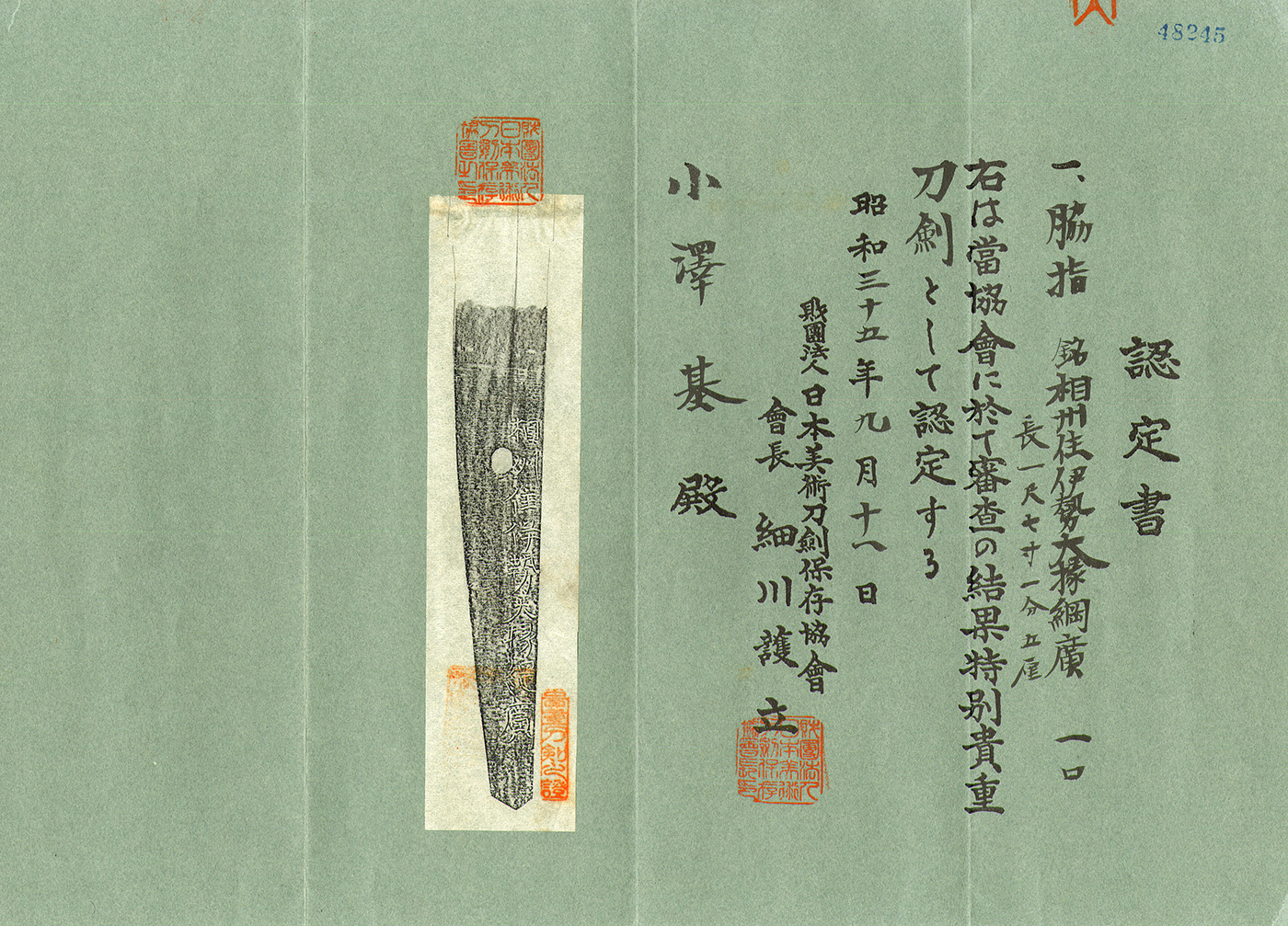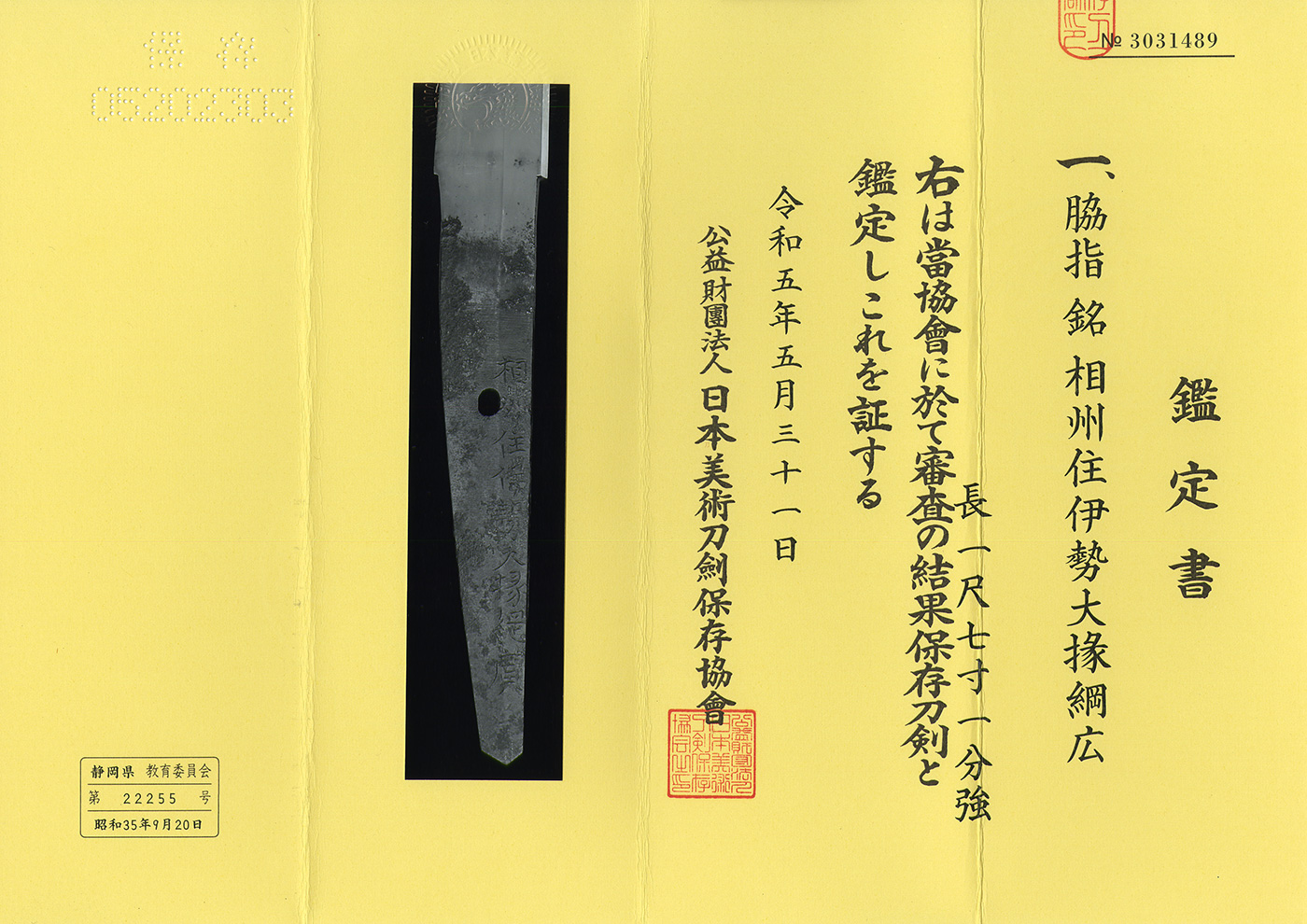Ordering number:22682
Wakizashi in Shirasaya with Koshirae (Hozon Token, Tokubetsu Kicho Token)
Signature: Soshu Ju Ise Daijo Fujiwara Tsunahiro
Shinto: Wazamono, Jyo Saku, Sagami
We divide swords into four categories: Saijyo Saku, Jyojyo Saku, Jyo Saku, and Regular Saku based on the swordsmith’s skill.
This work is ranked as Jyo Saku for Soshu Ju Ise Daijo Fujiwara Tsunahiro.
Polished
Habaki: Silver-plated, single layer
Blade Length: 52.0 cm (20.47 in)
Curvature: 1.0 cm (0.39 in)
Mekugi Hole: 1
Width at Base: 3.03 cm (1.19 in)
Width at Tip: 2.03 cm (0.80 in)
Thickness: 0.65 cm (0.26 in)
Sword Weight: 490 grams (1.08 lbs)
Era: Edo period, 5th generation Tsunahiro, circa 1658
Shape: The blade has a wide mihaba, normal thickness, and curvature, with a slightly larger tip.
Jigane: The ko-itame pattern is well-forged, resulting in an excellent texture.
Hamon: The nie is well-forged, featuring a deep nioiguchi with a double-layered hamon. There are ashi (legs) in the hamon, and the boshi is slightly sagging with a mixture of double-layered hamon.
Features: Tsunahiro was a swordsmith from Kamakura, Soshu province. It is said that the first generation received the character "Tsun" in his name from Hojo Ujitsuna after forging a sword for the Tsurugaoka Hachimangu Shrine. Ise Daijo Tsunahiro, the fifth generation, received the title of Ise Daijo in Manji 3 (1660) and later became Ise no Kami. He retired in Genroku 9 (1696) and passed away in 1700 at the age of 83. The Tsunahiro lineage continues to this day, and the fifth generation is considered the most skilled of the Shinto-period Tsunahiro swordsmiths. Some sources claim he was the teacher of Kotetsu.
Koshirae:
Tsuba: A round iron tsuba depicting a figure gazing at the moon in the sky, with nearby grass delicately inlaid in gold. The reverse side features grass and flowing river patterns.
Fuchikashira: The design features a raised carving of a meeting scene by the seaside, with parts inlaid in gold.
Saya: The saya has a textured surface with a wrinkled pattern.
Menuki: The menuki appears to depict a bird captured by a bow and arrow, with the bird inlaid in gold, evoking a unique elegance.
Seppa: Two seppa with a copper base wrapped in gold.
Aoi Art’s Comment: This Soshu-den work by Soshu Ju Ise Daijo Fujiwara Tsunahiro from Sagami province is a rare and highly recommended piece, especially with the well-preserved koshirae.
Hozon Token Certificate
Tokubetsu Kicho Token Certificate
Aoi Art Certificate
Whole Oshigata
Price:450,000JPY
商談中 HOLD
Related Items:
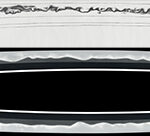 Wakizashi: (Kiku Mon) Harima Daijo Fujiwara Tadakuni(4th generation)(NBTHK Tokubetsu Hozon Token)
Wakizashi: (Kiku Mon) Harima Daijo Fujiwara Tadakuni(4th generation)(NBTHK Tokubetsu Hozon Token)
 Wakizashi:Omi Daijo Fujiwara Tadahiro(NBTHK Hozon Token)(NBTHK Tokubetsu Kicho Token)
Wakizashi:Omi Daijo Fujiwara Tadahiro(NBTHK Hozon Token)(NBTHK Tokubetsu Kicho Token)
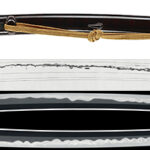 Wakizashi: Dewa Daijo Fujiwara Kunimichi(NBTHK Tokubetsu Hozon Token) (Consignment Sale)
Wakizashi: Dewa Daijo Fujiwara Kunimichi(NBTHK Tokubetsu Hozon Token) (Consignment Sale)
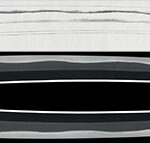 Wakizashi: Omi Daijo Fujiwara Tadayoshi (4th Generation)(NBTHK Tokubetsu Hozon Token)
Wakizashi: Omi Daijo Fujiwara Tadayoshi (4th Generation)(NBTHK Tokubetsu Hozon Token)
 Wakizashi: Omi Daijo Fujiwara Tadahiro(NBTHK Tokubetsu Hozon Token)
Wakizashi: Omi Daijo Fujiwara Tadahiro(NBTHK Tokubetsu Hozon Token)
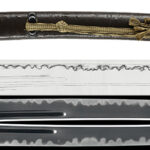 Wakizashi: Soshu Ju Yasuharu (NBTHK Tokubetsu Hozon Token)
Wakizashi: Soshu Ju Yasuharu (NBTHK Tokubetsu Hozon Token)




